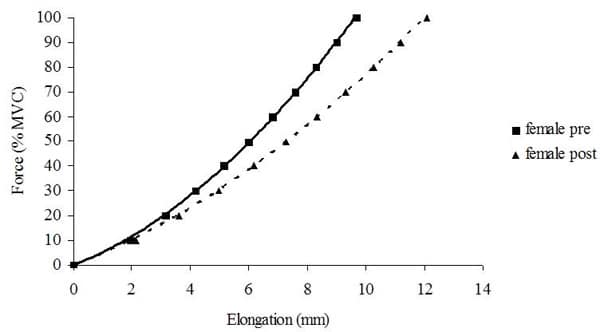Gastrocnemius tendon stiffness in males has been shown to decrease significantly following tensile loading (Kubo et al. 2001). This decrease in tendon stiffness has been proposed as a mechanism for diminished performance following stretch (Cornwell et al. 2002), and may also lead to increased injury risk by increasing the strain experienced by the tendon at any given load (Reeves, 2006). No previous study has examined the relationship between tensile loading and subsequent mechanical changes in female tendon. Therefore, the aim of the present study was to examine and compare the effect of acute tensile loading on the mechanical properties of both female and male gastrocnemius tendon. Twenty one subjects (Female n = 8; Male n = 13) performed a five minute passive dorsiflexion stretch. Prior to and post tensile loading medial gastrocnemius tendon stiffness (k), length (l) and cross-sectional area (csa) was measured using ultrasonography and dynamometry. The investigation was approved by the institutional ethics committee and conformed with the principles of the World Medical Association’s Declaration of Helsinki. Student’s t tests were used to analyse data, alpha values were set to p < 0.05. Stiffness was significantly reduced with tensile loading. Females showed significantly (p < 0.05) greater pre to post tensile loading decreases in k (24.4% vs. 11.8%) in comparison to males (see figures 1 and 2). Prior to tensile loading k was significantly less for females than males (p<0.05). Percentage change in maximal strain was significantly greater in females (Female 30.4 vs. Male 10.0%) (p < 0.05). There were no significant changes in l or csa for either gender following tensile loading. The present results show that acute tensile loading reduces stiffness of the gastrocnemius tendon in both females and males, with females showing significantly greater change. The observed disparity between genders may be due in part to variations in initial stiffness and intrinsic differences in tendon composition. These differential changes in tendon mechanical properties have functional and motor control implications.
Life Sciences 2007 (2007) Proc Life Sciences, PC72
Poster Communications: Effect of acute tensile loading on gender-specific tendon mechanical properties
K. E. Burgess1, P. Graham-Smith1, S. J. Pearson1
1. University of Salford, Manchester, United Kingdom.
View other abstracts by:
Female force elongation pre and post stretch. Decreased gradient post stretching illustrates reduction in k
Male force elongation pre and post stretch.
Where applicable, experiments conform with Society ethical requirements.


